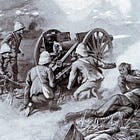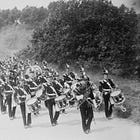At the end of the nineteenth century, two German companies built artillery pieces. The larger of these concerns, which bore the famous name of Krupp, produced guns and howitzers of conventional types. The smaller, known as Ehrhardt, took greater risks in the realm of design.
In 1888, Konrad Haussner, an engineer working for Krupp, designed an on-carriage recoil-absorbing mechanism for field guns. However, when he presented this invention to his superiors in the company, they judged it to be impractical. Soon thereafter, Herr Haussner quit Krupp, took out a patent for his device, and went to work for Ehrhardt.
In the 1890s, French engineers working on the project that would result in the famous 75mm field gun of 1897, borrowed much from Haussner’s design. In the same decade, Ehrhardt designed quickfiring artillery pieces of its own.
Early in the Second-Anglo Boer War, Ehrhardt sold one hundred and eight copies of one of these weapons to the British War Office. Custom tailored to fire the same projectiles as the 15-pounder breech-loading field gun then serving with the Royal Field Artillery, this weapon, which appeared in the Ehrhardt catalog under the designation ‘Model 1900’, became known as the ‘QF 15-pounder gun’.1
While designed as a full-size field gun, the War Office issued the ‘QF 15-pounder’ to some, but far from all, of the twenty-six batteries of the Royal Horse Artillery. (As each battery of the Royal Horse Artillery rated six guns, one hundred and eight guns sufficed to arm eighteen batteries. I suspect, however, that as many as eighteen of the new guns found their way into an arsenal, there to serve as replacements for guns in need of substantial repair.)2
Both parties to the acquisition of new guns for the Royal Horse Artillery took pains to avoid publicity. War Office officials knew that, at a time when several British firms manufactured field pieces, many of their countrymen would object to the acquisition of foreign ordnance. At the same time, the employees of Ehrhardt understood that, at a time when German popular sympathies lay squarely with the Afrikaner republics, the sale of weapons to the British Empire would prove unpopular. Nonetheless, it did not take long for complaints about the purchase to appear in both Parliament and the press.3
In 1901, and thus before the first anniversary of the purchase of the QF 15-pounder, the War Office commissioned a board to lay down requirements for a pair of new field guns, a lighter piece for service with horse artillery batteries and a heavier weapon for the use of field batteries. Three years later, horse artillery units of the Regular Force began to trade their ordnance for copies of the weapon built in response to these desiderata, the QF 13-pounder field gun. In 1908, many of the Ehrhardt guns made available by this exchange reported for duty with the fourteen horse artillery batteries of the newly formed Territorial Force.4
Handbook for the QF 15-Pounder Gun (London: HMSO, 1905)
In 1901, Lord Stanley, then serving as the financial secretary to the War Office, informed the House of Commons that fifteen batteries of the Royal Horse Artillery had been equipped with the Ehrhardt gun. Loebells Jahresberichte (1901) page 381
Some details of the purchase of the Ehrhardt guns, and the opinions of some who opposed it, can be found the stenographic record of a debate that took place in the House of Commons on 31 July 1902. Hansard Army Excesses Volume 112









Amazing that it took a German ordnance firm to deliver such an advanced, although not perfect, weapon to the British Royal Artillery.
Did these guns serve in WW1 ?